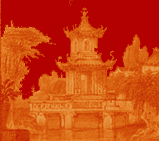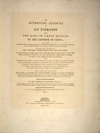
Europeans quickly saw the value of trade with China. By 1699 the British and the Dutch East India companies had established factories and warehouses - at Canton (Guangzhou), gradually replacing the Portuguese as the dominant European traders and colonizers in Asia. This lead to a series of diplomatic overtures to China, designed to establish more extensive trading relations. Official emissaries were sent from Britain, Holland, France and Russia. These official delegations did not succeed in their aim, often foundering first of all on the Chinese insistence that the visitors should acknowledge their subordination to the Emperor, as was customary for representatives of foreign rulers when visiting the Emperor of China. In their journeys to Peking (Beijing), the delegations had the opportunity to see more of China than other foreigners, so that the accounts of their visits were read with great interest.
The 17th and 18th century positive opinion of China began to be replaced by its opposite in the course of the nineteenth century, as more observers saw evidence of despotism and corruption. Their perceptions were fuelled in part by political revolution and constitutional change in Europe. Europeans, also experiencing rapid technological and social change, now saw the unchanging nature of China as an indication of a stagnant and decadent society.












